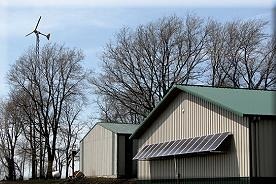Reviewing last week's solar energy news
 Turkey day has come and gone. People are now wrapping their homes with their solar-powered Christmas lights and preparing for the Yule season and all that it entails. Even with the short days in the northern hemisphere, solar continues to gain interest in the U.S. and around the world. One organization co-opted the popular “Occupy” moniker to promote community solar around the world, while a new report showed that middle-class U.S. residents outpaced the rich in terms of installing solar on their homes.
Turkey day has come and gone. People are now wrapping their homes with their solar-powered Christmas lights and preparing for the Yule season and all that it entails. Even with the short days in the northern hemisphere, solar continues to gain interest in the U.S. and around the world. One organization co-opted the popular “Occupy” moniker to promote community solar around the world, while a new report showed that middle-class U.S. residents outpaced the rich in terms of installing solar on their homes.
The popular or infamous (depending on your preference) Occupy Wall Street movement was recently co-opted by Solar Mosaic, a company working with communities to install solar through micro-financing or crowd funding. The company introduced its Occupy Rooftops campaign last week. As part of the campaign, Solar Mosaic and its partners created Web-based tools to help communities learn how to finance solar projects and is offering five, $1,000 seed grants to help such projects get underway. It officially launched the campaign on Nov. 20, which it said was Community Solar Day, and asked people across the world to submit pictures of the people and the community centers that would benefit from solar.
You might think rich people are adopting solar faster than other economic classes, since they have the most money to invest—you’d be wrong, at least in the U.S. A new report from PV Solar Report and SunRun showed that the majority of homeowners installing solar in California are middle income ones. SunRun, a company that offers third-party ownership of solar, said that since 2009, two-thirds of all installations on homes were made in ZIP codes where homeowners had an annual average combined salary of $85,000 a year or less. The report also found that in the wealthiest ZIP codes (90210-anyone?) only 2 to 3 percent of homeowners are going solar.
Another third-party owned residential solar company is taking solar leases internationally. Last week, Sungevity announced that it was partnering with the Dutch solar installer Zonline to offer third-party ownership in the Netherlands. It’s likely the first such U.S.-based company to offer the third-party ownership model overseas. However, the financing mechanism is a bit different in the Netherlands than it is in the U.S. There the utility is financing installations through another financial institution and the homeowner repays for the system over time.
South America hasn’t been considered the hot spot for solar, but that might be changing. California-based Tegal Corp.’s Sequel Power subsidiary recently opened up offices in Chile and Argentina in an attempt to develop large solar projects in the continent’s biggest economies of Argentina, Brazil and Chile. Sequel Power plans to first pursue a large-scale solar project in Argentina, the company said.
Most of the solar installation news these days surrounds large-scale solar and residential solar. But the market that led solar growth for a long time was the small commercial market—installations generally under 1 megawatt in size. That market has fallen into near obscurity and is having problems securing funds. A new working group being put together by Solartech and CalCEF is aiming to change that. The companies are working to improve the flow of capital to such projects, which include warehouses, retail stores, supermarkets and the like.
If successful, they’ll help more companies like GloPak go solar. That company completed a 532-kilowatt installation on its rooftop in Plainfield, N.J. It’s also installing a 469-kilowatt ground array slated for completion in January 2012.
Image courtesy of Illinois Solar Tour 2011.



